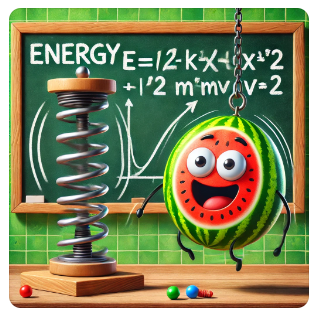6.2 Energy of a Simple Harmonic Oscillator
Conservation of Energy in SHM
Energy in a simple harmonic oscillator is conserved. This means that the total energy remains constant as it oscillates between potential and kinetic energy.
Internal Energy
A system with internal structure can have internal energy, which can change due to the system’s internal structural changes.
Key Points:
Definition: Internal energy (ΣU) refers to the random, chaotic motion of an object’s particles and is a measure of thermal energy.
SHM Context: Internal energy manifests as elastic potential energy when displaced from equilibrium. This energy alternates between kinetic and potential energy during oscillation.
Behavior: The internal energy in SHM is periodic. It’s maximum at maximum displacement and minimum at equilibrium.
Equation:
where is the spring constant, and is the displacement.
Significance: Internal energy helps explain energy conversions in SHM.
Potential Energy in SHM
Potential energy exists within systems when objects interact with conservative forces.
Key Points:
Definition: Potential energy (ΣU) is stored energy based on position or configuration.
SHM Context: In oscillators, potential energy is stored elastically due to spring deformation when displaced.
Behavior: Periodic, maximum at maximum displacement, and minimum at equilibrium.
Equation:
Significance: Understanding potential energy is crucial for analyzing energy storage and conversion.
Kinetic Energy in SHM
Kinetic energy is associated with the motion of objects.
Key Points:
Definition: Kinetic energy (ΣK) quantifies the ability to do work due to motion.
SHM Context: Maximum at maximum velocity (equilibrium), and minimum at maximum displacement.
Behavior: Periodic, alternating with potential energy.
Equation:
where is the mass, and is velocity.
Significance: Kinetic energy reveals motion dynamics during oscillation.
Energy Conversion in SHM
The total energy in SHM alternates between potential and kinetic energy, maintaining a constant sum.
Key Features:
At Maximum Displacement: Potential energy is maximum, kinetic energy is zero.
At Equilibrium: Kinetic energy is maximum, potential energy is zero.
Graph Insights:
Total energy remains constant.
Potential and kinetic energy graphs follow a periodic curve due to the squared terms in their equations.
Peaks in potential energy align with displacement maxima, while kinetic energy peaks coincide with velocity maxima.
Example Problems
Example 1: Total Energy at Maximum Displacement
Problem: A 1 kg mass on a spring () oscillates vertically without friction. The displacement is 0.2 m from equilibrium. Calculate the total energy.
Solution:
Total energy is the sum of potential and kinetic energy.
At maximum displacement, velocity is zero, so energy is entirely potential.
Answer: Total energy is .
Example 2: Total Energy at Equilibrium
Problem: A 2 kg mass on a spring () oscillates vertically without friction. The displacement is 0.5 m from equilibrium. Calculate the total energy at equilibrium.
Solution:
At equilibrium, potential energy is minimum (zero), and total energy equals kinetic energy.
Answer: Total energy is .







